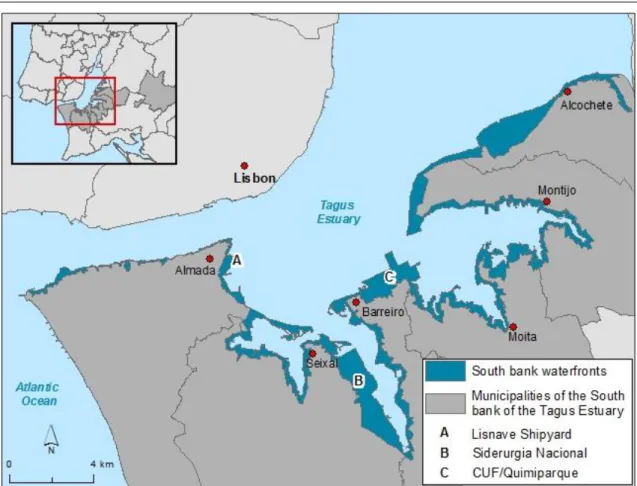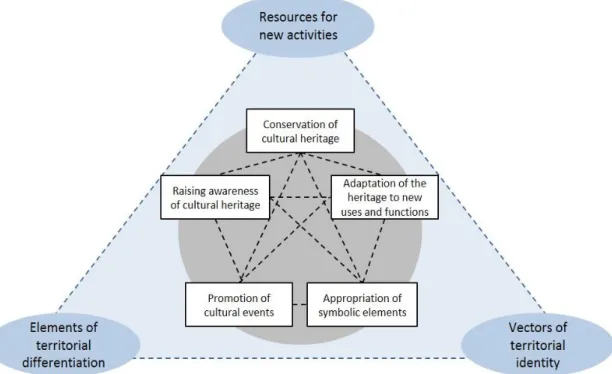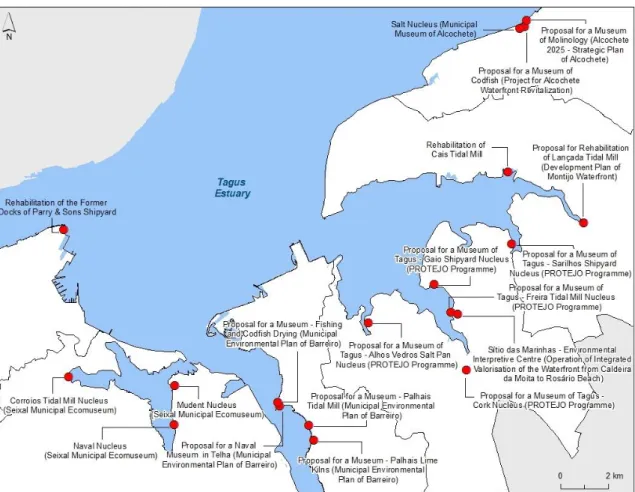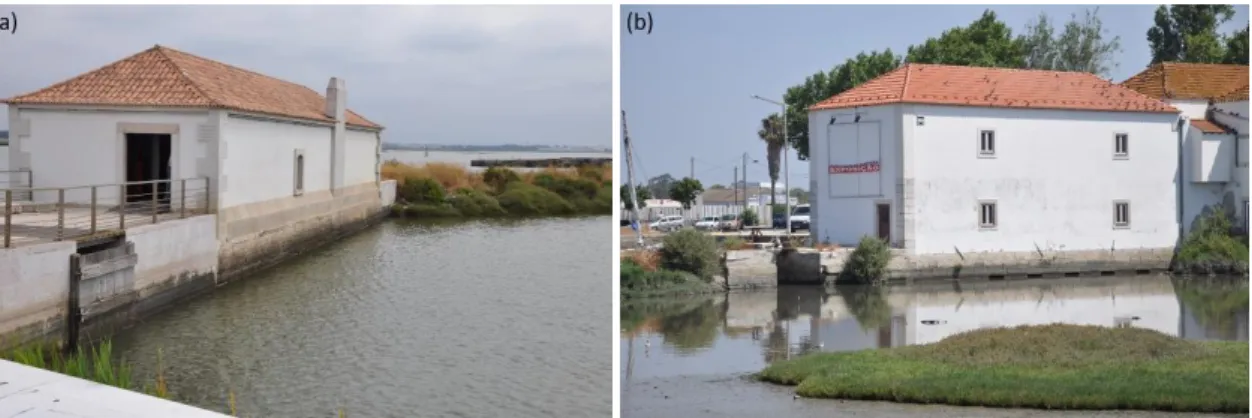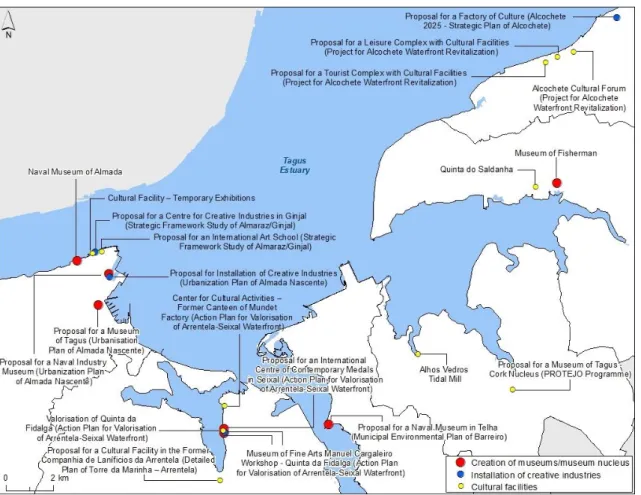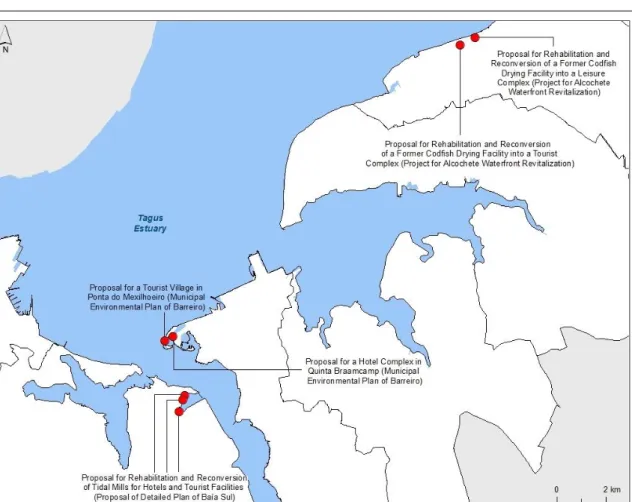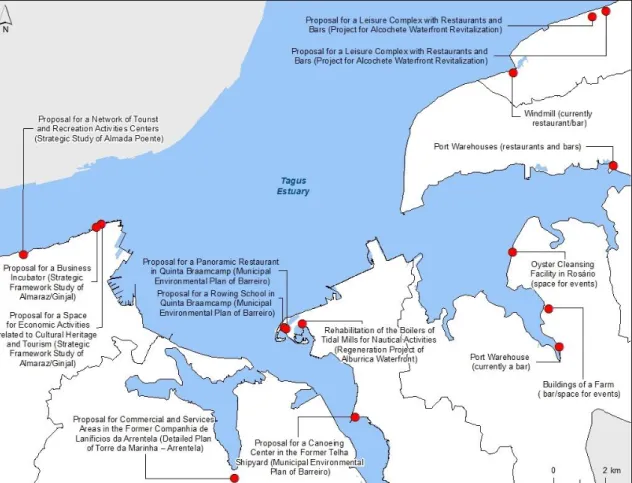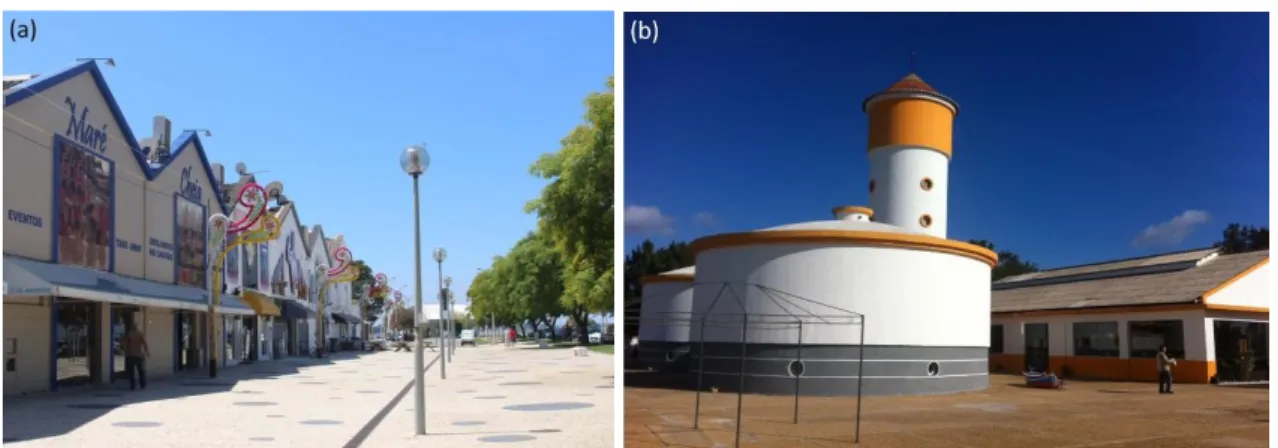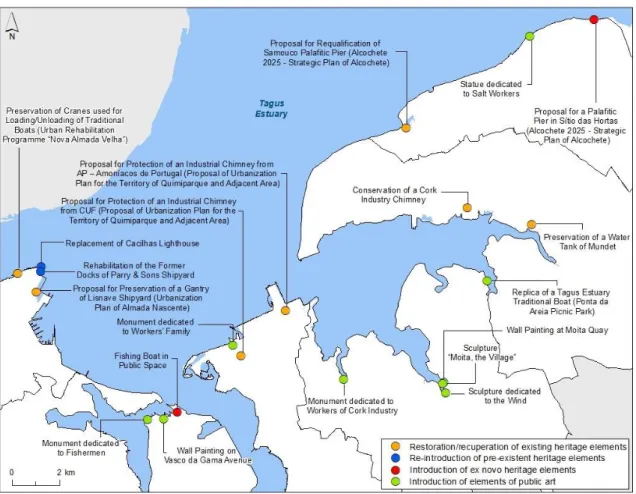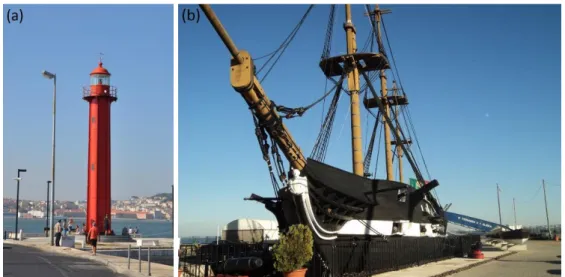The Cultural Heritage in the Post-Industrial Waterfront: a case study of the South bank of the Tagus Estuary, Portugal
André FernandesI, João Figueira de SousaII and Regina SalvadorIII
I Interdisciplinary Centre of Social Sciences, Faculdade de Ciências Sociais e Humanas,
Universidade Nova de Lisboa (CICS.NOVA.FCSH/UNL) Avenida de Berna, 26 C, 1069-061, Lisboa, Portugal. Email: andre.fernandes@fcsh.unl.pt
II Interdisciplinary Centre of Social Sciences, Faculdade de Ciências Sociais e Humanas,
Universidade Nova de Lisboa (CICS.NOVA.FCSH/UNL) Avenida de Berna, 26 C, 1069-061, Lisboa, Portugal. Email: j.fsousa@fcsh.unl.pt
III Interdisciplinary Centre of Social Sciences, Faculdade de Ciências Sociais e Humanas,
Universidade Nova de Lisboa (CICS.NOVA.FCSH/UNL) Avenida de Berna, 26 C, 1069-061, Lisboa, Portugal. Email: regina.salvador@fcsh.unl.pt
Abstract
Considering the process of waterfront revitalization on the South bank of the Tagus Estuary in the post-industrial era, it is possible to reveal a commitment to appropriation and valorisation of the heritage and cultural identity inherited from preceding economic cycles. Using a qualitative approach, backed up by a detailed analysis of territorial planning instruments, strategic documents and intervention projects, it was possible to identify three main dimensions of appropriation aimed to valorise the heritage and cultural identity, considering them as (i) resources for the promotion of various activities, (ii) vectors for strengthening territorial identity, (iii) elements of territorial differentiation. Analysing these dimensions, the article presents a proposal for classification of the actions proposed for their implementation, namely: conservation of cultural heritage, adaptation of the heritage to new functions and uses, appropriation of symbolic elements, and raising awareness of cultural heritage among local communities.
Keywords: Cultural Heritage, Waterfronts, Redevelopment Processes, Post-Industrial
Introduction
The waterfront revitalization process that has bloomed in the post-industrial era is a global phenomenon (Schubert, 2011; Gunay & Docmeci, 2012; Fernandes & Figueira de Sousa, 2014; Chen, 2015), which emerged initially as a response to continuous abandonment and decay of areas previously occupied by port and industrial activities. Generally, these interventions aimed to requalify and, consequently, integrate and reappropriate these spaces by providing a mix of new uses and activities (Sieber, 1997; Bruttomesso, 2001). As Shu and Qin (2004) point out, “waterfronts have been imagined as a concentration of functions that can be productive, cultural, relational, recreational, residential and public” (p. 1074), a guideline that describes functional transformation occurring on urban waterfronts in post-industrial era, being strongly related to the need to satisfy cultural demand and to consolidate the post-fordist city. Thus, the process occurred in the context of a changing paradigm between a city of production and a city of consumption, as Zukin (2010) stated referring to the loss of city authenticity.
However, waterfront revitalization is not confined to port cities. Regarding this matter, Hoyle (2000) reminds that this process has also extended to rural waterfront locations. Therefore, these interventions should not be considered as a simple reaction to functional obsolescence of waterfronts in port cities, repercussion of economic and technological transformations which influenced significantly maritime transports and ports. On the contrary, many cities assessed positively the interventions considering them as an opportunity to revitalize urban economy (Bruttomesso, 2001). It can also be observed that many waterfronts were assumed “as catalysts for city renewal” (Millspaugh, 2001), while other cities used the interventions in order to create and promote a new image of the intervened areas. Analysing the transformations of Liverpool waterfront, Roberts (2010) points out the way waterfront’ image has been commodified and adopted in the city’s marketing. In addition, as Fagence (1995) highlights that “the principal purposes of waterfront redevelopment include the achievement of public access to waterfront, improvement to the image of derelict waterfront areas, and the achievement of economic regeneration (…)” (p. 137). Haas
and Olsson (2014), though do not limit their analysis to waterfronts, emphasize specifically that in the context of structural transformations of the last decades “the construction of place (place making) is characteristic of many cities undergoing urban transformation from centers for production to centers of consumption” (p. 59). Analysing the transformation process of urban spaces, Allon (2013) interprets the urban regeneration processes from the viewpoint of capitalist accumulation. Accordingly to the author, there is a cyclical process that should be taken into account, in which “the landscape of industrial capitalism is superceded by a new set of more profitable physical structures along with new social relations and ways of life (…)” (Allon, 2013, p. 280). Based on the case of Spree (Berlin), the author also discusses the effects of these social and spatial transformations of waterfronts, including the conflicts it can arise.
Tagus Estuary South bank waterfronts (a territory composed by the municipalities of Almada, Seixal, Barreiro, Moita, Montijo and Alcochete, which are part of the Lisbon Metropolitan Area) - Figure 1 - are example of areas which are not port waterfronts
stricto senso (Fernandes & Figueira de Sousa, 2014). It is a territory of land-water
interface which has been subject to various territorial planning instruments, strategic documents and intervention projects that aimed its revitalization, though they were only partially implemented. The need to act was driven by progressive decay and functional obsolescence occurred in the process of transition to post-industrial era which resulted in abandonment of vast areas of this territory. Apart from urban and natural areas, the territory also hosted multiple functions and economic activities, from salt production and agriculture to large industrial complexes related to chemical industry (CUF/Quimiparque), steel industry (Siderurgia Nacional) and ship construction/repair (Lisnave shipyards). This set of functions and activities, spread out in various locations, influenced the essence of revitalization interventions applied to the waterfronts, in particular: requalification operations on urban waterfronts, regeneration interventions of abandoned or derelict industrial areas, interventions targeting environmental revalorization of natural waterfronts.
Figure 1. Location of the Tagus Estuary South bank waterfronts.
Source: Author.
Considering these interventions, it is possible to state that the proposals for valorisation of the heritage and cultural identity were numerous and diverse. In this regard, the article aims to discuss the dimensions of cultural and patrimonial elements’ appropriation, providing a proposal for classification of actions which were planned to be implemented as part of the interventions elaborated for the Tagus Estuary South bank waterfronts.
In order to achieve this purpose, a qualitative approach was adopted which required detailed analysis of territorial planning instruments, strategic documents and intervention projects elaborated for the territory, complemented by direct observation of the interventions in order to analyse and understand forms of appropriation and valorisation of the heritage and cultural identity. Anticipating the presentation and discussion of the results, a brief literature overview is provided, meant to ponder a value-oriented approach to heritage and cultural identity in the context of
revitalization projects on waterfronts and in order to elaborate a framework to interpret the process occurred in the study area.
Appropriation of cultural heritage in waterfronts’ revitalization processes
In the context of waterfronts’ revitalization interventions, appropriation and valorisation of heritage and cultural elements has formed a common approach. According to Fagence (1995), “one of the consistent elements of the strategies of waterfront economic regeneration has been the advantage taken of rehabiliting heritage buildings” (p. 140). Besides that, various authors have been trying to understand the foundation and form of this value-oriented appropriation and how it is expressed. For example, Shaw (2001) regards the choice to preserve the elements inherited from previous uses that has been observed from the first generation of urban waterfront development as “a growing awareness of the value and usefulness of heritage and a reaffirmation of local and national identity in the face of the challenges of globalization” (p. 162). Meanwhile, Marshall (2001) highlights the role of these elements in preservation of territorial identity, stating that “the preservation of our built historic fabric is important to the creation of identity and the preservation of character” (p. 137). This analysis strengthens the interpretation of Brink (as cited in Breen & Rigby, 1994), according to whom the presence of these elements contributes to preservation of character and specific features of each waterfront.
From a practice-oriented perspective, Sieber (1997) based on North American cities states that valorisation of cultural elements is strongly linked to the need to establish connections to a territory and its traditions by new users of these areas. According to Sieber, in the context of waterfront redevelopment processes these connections can be achieved through three different approaches: environmentalism, history and heritage, and tourism and public celebration (Sieber, 1997, p. 138). In a recent work, Fernandes (2015a) also presented a proposal for systematization of forms of appropriation that targets valorisation of heritage and cultural identity, identifying six main approaches envisioned from a practice-oriented perspective. The first approach mostly refers to conservation and functional reconversion of built heritage as a form of affirmation of territorial identity and contribution to its differentiation. The second
approach concerns conservation and preservation of cultural heritage for example through musealisation. The third approach is focused on valorisation of the heritage as symbolic element that establishes links to pre-existent uses and functions on an intervened territory. Something that should be also interpret in a broader sense, has a way to promote and create a “symbolic landscape” (see Roberts, 2010). The fourth approach is related to promotion of the heritage as a support to new cultural industries and is based upon the practice of “using these buildings for cultural and artistic activities, being at the same time a form of strengthening its attractiveness and a way to create new centers in cities” (Fernandes, 2015a, p. 5; author’s translation). The fifth approach includes the promotion of cultural events that celebrate culture and identity of an intervened territory and are destined to differentiated audiences. Finally, the sixth approach concerns valorisation and promotion of the heritage as a resource for tourism and leisure activities while a waterfront is perceived and promoted as a tourist product.
These different approaches to cultural heritage appropriation in waterfronts’ revitalization processes also underline some important issues around urban policies. One of them concerns policies on conservation of urban landscape heritage, namely the discussion on a changing focus from an approach that emphasizes the preservation of individual elements to an inclusive one, which valorises historic urban landscapes (for a systematic discussion of this issue see Whitehand & Gu, 2010). For instance, while some waterfront redevelopment processes have been more focused on the rehabilitation of individual elements (e.g. heritage buildings, monuments), others tended to recognize waterfronts within a holistic perspective, as part of the historic urban landscape. Discussing the current approaches on post-industrial land transformation, Loures (2015) points out the importance of a contextual approach to these post-industrial landscapes, which should take into account several issues, like ecological restoration, cultural preservation or economic development.
Heritage and cultural identity in waterfront revitalization: the South bank of the Tagus Estuary
The process of waterfronts revitalization on the South bank of the Tagus Estuary began in the 1980s when various interventions upon this territory were implemented and local municipalities initiated the elaboration of territorial planning instruments, strategic documents and revitalization projects at a local scale. Many of these operations were not implemented and the most expressive example of this situation is the case of brownfields that correspond to industrial complexes of the second regional cycle of modern industrialization. Nevertheless, the analysis of implemented plans and projects, and also the interpretation of those ones which were not implemented, allow to state that appropriation and valorisation of the heritage and cultural identity has been a common approach.
The adopted methodology allowed to distinguish the existence of three major dimensions of value-oriented appropriation of the heritage and cultural identity in this process: (i) as resources for promotion of various activities; (ii) as vectors that strengthen territorial identity; (iii) as elements of territorial differentiation. The first dimension is strongly connected to regional dynamics of waterfront affirmation as “places of leisure”. These dynamics was enforced by an intention to ease the transition of this territory to a new cycle of occupation supporting the emergence of new trend in development which aims the creation of a new post-industrial landscape. In this context, heritage and cultural elements are recognized as important components of economic history of this territory and are incorporated predominantly as resources of support to the development of new activities which should impulse waterfront revitalization, targeting in particular tourism and leisure and, to less extent, cultural industries.
At the same time, value-oriented appropriation of the heritage and cultural identity that is focused on strengthening territorial identity is supported by pro-activity of local agents in the course of interventions, meaning the beginning of a patrimonialisation process of elements inherited from previous economic cycles. In fact, considering the values that form cultural identity of these communities, such elements are recognized
as symbolic representations and meaningful components of this identity (Fernandes, 2015b). Their rehabilitation or conservation in the context of interventions are linked to the following aims: (i) apply this identity matrix to territory strengthening the “sense of place” (Fernandes, 2015b); (ii) grant a territory with heritage elements that would formalize the preservation of collective memory, raise awareness about the heritage and reinforce connection and identification with territory; (iii) provide resources that would support new activities; (iv) provide elements (or resources) that could be valorised in the context of a strategy for territorial differentiation.
Concerning the dimensions of appropriation of the heritage and cultural identity as elements of territorial differentiation, it is necessary to acknowledge the value and utility of this elements in the context of broader strategies of differentiation of the territory that aim to strengthen competitiveness and also increase attractiveness on various scales: local, regional, national and international (Fernandes, 2015b). An approach focused on capture of subsidiary investments from implementation of guidelines elaborated for the transformation of this territory (for example, urban projects) or on rising the attractiveness for differentiated demands (tourist, leisure demand or cultural services). Thus, such elements are considered particularly important in strategies of differentiation by image and by support. In the first case the main concern is the creation of images with a “sense of place”. In the second case the importance of these elements is related to the fact that they represent unique patrimonial resources, both in terms of cultural legacy inherited from previous economic cycles, and in terms of natural heritage (for example, natural values in protected areas or the landscape formed by the water scene of the Tagus Estuary). Using this systematization, Figure 2 represents a schematic synthesis which is based on the results of documents’ analysis and field work, and intends to show that existing interaction between these major dimensions of value-oriented appropriation does not imply their mutual exclusion. In other words, the way how these dimensions function in the framework of territorial planning instruments and revitalization projects for waterfronts reveals strong complementarity between them. For example, interventions that promote appropriation of heritage elements as support to new
activities would also contribute to territorial identity affirmation and constitute elements of territorial differentiation.
Figure 2. Heritage and culture dimensions in waterfronts revitalization interventions.
Source: Author.
From another perspective, Figure 2 also offers a proposal for classification of actions that aim to operationalise these dimensions in the context of waterfronts revitalization on the South bank of the Tagus Estuary. Considering the nature and objectives of these interventions, the research allowed to conclude that these actions can be classified in the following way: conservation of cultural heritage; adaptation of heritage to new uses and functions; appropriation of symbolic elements; promotion of cultural events, raising awareness of cultural heritage among local communities.
Waterfront revitalization and the conservation of cultural heritage
Conservation, restoration and rehabilitation of cultural heritage have been sustained by interventions on the waterfronts of the South bank of the Tagus Estuary. From the perspective of a dimension related to appropriation of the heritage and cultural identity as resources for new activities, such actions target predominantly the creation of new tourist and leisure resources (for example, in the perspective of cultural touring), that induce diversification and qualification of tourist facilities and also raise
the attractiveness of this territory. Example of this approach is the initiative to create museums through rehabilitation of outstanding structures (mostly buildings) and through conservation of existing heritage linked to economic activities developed in the different cycles of waterfronts occupation. The intention is to preserve and safeguard this heritage and create resources able to promote and qualify the offer and strengthen the attractiveness of the waterfronts (Figure 3).
These actions also tend to include a regulatory branch (apart from legal mechanisms for protection and safeguarding of classified heritage), existing various territorial planning instruments, strategic documents and intervention projects that emphasize the need to apply measures of heritage protection. For example, “Municipal Master Plan of Montijo” determines easements for various buildings located on the waterfront, including: Cais tidal mill, Assentas tidal mill, Lançada tidal mill, Vapores quay and Nosso Senhor Jesus dos Aflitos chapel - Quinta do Saldanha.
Figure 3. Examples of proposed actions for conservation of the cultural heritage.
On the other hand, these actions tend to contribute to formulation of vectors that would strengthen territorial identity and promote restoration and conservation of elements that have historic or cultural value. Through patrimonialisation processes, such elements become instruments of promotion and communication of local history. The Cais (Montijo) and Alhos Vedros (Moita) tidal mills may serve as examples - Figure 4. Rehabilitation of the first one was finished in 2005 and the second one in 2007, offering since then a contact with methods and techniques of traditional milling. These facilities also contribute to valorisation of the heritage inherited from previous economic cycles, to affirmation of territorial identity and to collective memory safeguard. In the case of the Alhos Vedros tidal mill, besides the museum, it also hosts a multifunctional space for temporary exhibitions and other cultural events.
Figure 4. Cais tidal mill (a) and Alhos Vedros tidal mill (b), 2013.
Source: Author.
From the perspective of appropriation of the heritage and cultural identity as elements of territorial differentiation it is interesting to observe that various interventions of waterfront revitalization contemplate actions aimed for heritage conservation as they can contribute to qualification and attractiveness of intervened areas, promoting the creation of a portfolio of unique cultural resources. For example, the “Urbanisation Plan of Almada Nascente” (approved in 2009) perceives that cultural heritage and local history promotion are means to valorise the identity and differentiate the territory of intervention. Also the “Strategic Charter of the Municipality of Moita - Moita 2010” (Câmara Municipal da Moita, 1999) selects the Tagus Estuary and the waterfront as resources for the development of touristic and leisure activities, aiming to valorise both natural and cultural assets. These unique cultural resources allow a
value-oriented appropriation of elements that can hardly be reproduced in different territorial contexts as they were inherited from occupation cycles which benefitted from specific location and location attributes, in particular from singular characteristics of a particular place (i.e. estuarine area) and geographic location (i.e. proximity to the city and port of Lisbon).
Waterfront revitalization and the heritage adaptation to new uses and functions
Adaptation of the heritage to new uses and functions represents another type of action focused on appropriation of the heritage (especially historic buildings) regarding it as: (i) support for the development of new urban functions coherent with transformation strategies outlined in territorial planning instruments applied to this territory; (ii) support to installation of new activities; (iii) instruments for strengthening territorial identity; (iv) elements able to differentiate the territory. A process that resulted from the loss of practical use of these elements, gradually becoming obsolete and abandoned, whose conservation was not included in the first type of actions (i.e. conservation of cultural heritage). Generally, this type of actions suggests a reinvention of buildings through attribution of new functions (i.e. rehabilitation and functional reconversion), while simultaneously rehabilitation favours maintenance of their original architectural features as these possess historic, cultural and aesthetic value, being able to contribute to preservation of local memory, related to the activities that were carried out on the territory. Thus it is natural that these actions, likewise the others, tend to reflect distinctive territorial expression of previous economic cycles, appropriating and valorising heritage elements related to economic activities that largely influenced the territory. It is also important to notice that these actions tend to strengthen symbolic connection of territory with the water body, due to functional relation of heritage with water (for example, tidal mills, port warehouses). As such it contributes to the reinforcement of the territorial identity related to water.
In a complex of interventions proposed for the study area it is possible to identify three main approaches. The first one concerns reconversion of the buildings into spaces for cultural activities, capable to attract investment, create jobs and increase waterfront attractiveness for new public (i.e. visitors and tourists). This approach
includes: (i) proposal for creation of museums/museum centers which implies adaptation of a building to these new functions, though without musealisation in situ; (ii) proposal for creation of spaces designed for creative industries linked to various activities (for example, performance arts, entertainment, fashion, design, cinema, advertisement and fine arts); (iii) proposal for creation of cultural facilities of varied nature (for example, spaces for performances, temporary exhibitions, ateliers, multifunctional spaces for diverse cultural events, art schools) - Figure 5.
Figure 5. Examples of proposed actions aimed to adapt the heritage for facilities/spaces designed for cultural activities.
Source: Author.
This approach also considers the dimension related to affirmation of vectors for strengthening territorial identity that is expressed in: (i) preservation of architectural characteristics of historical buildings, especially their facades which form unique elements that allow preservation of historic memory of these places; (ii) creation of museums which recuperate and preserve the heritage (though not in situ, as it is done in actions aimed for heritage conservation), promoting and spreading the history of
this territory (Figure 5). The Naval Museum of Almada may serve as an example, installed in a building of a former factory whose industrial traces were preserved. In the context of appropriation of the heritage and cultural identity as elements of territorial differentiation, this approach also intends to allow their valorisation through: (i) commitment to create cultural spaces/facilities of reference which would offer a cultural program attractive on a regional scale, thus strengthen waterfronts attractiveness for various categories of public and making them core components of urban revitalization on intervened areas; (ii) affirmation of waterfront elements which own unique features due to the connection of this territory with water body and preceding cycles of occupation, and thus can be assumed as points of reference; (iii) creation of a varied and cosmopolitan urban environment, especially in areas which are to be rehabilitated and converted into spaces for creative industries. Considering this last approach, it is necessary to mention a guideline outlined in the proposal for amendment of the “Regional Land Management Plan for the Metropolitan Area of Lisbon” (CCDRLVT, 2010) that understood brownfields inherited from the second regional cycle of modern industrialization as privileged spaces for creation and development of centers for creative industries.
Meanwhile the second approach refers to conversion of the built heritage into tourist projects (acknowledging the patrimonial value of a building or built complex already reconstructed or awaiting reconstruction, these actions also intend to value amenities provided by natural conditions existent in the area), thus trying to diversify and qualify existing regional offer and to boost this territory from economic and social viewpoint. There are various proposals inserted in this approach which, though not yet implemented, aim at creation of different solutions: hotels, tourist villages, tourist apartments, resorts, campsites and caravan camping (Figure 6).
Figure 6. Examples of proposed actions aimed to adapt heritage to hotels/tourist complexes.
Source: Author.
Similarly to the previous approach, the proposal for recuperation of the constructed heritage, which offers new functions linked to tourism, represents an innovative form of intervention. An approach that intends to ensure the conservation in situ, allowing not only heritage valorisation as a support to economic activity able to create jobs and boost related activities, but also the creation of positive externalities which contribute to affirmation of waterfront identity (for example, tidal mills or industrial units for codfish drying – Figure 5). On the other hand, this intention of value-oriented appropriation of the built heritage received from preceding economic cycles implies tacit acknowledgment that these elements constitute a form of differentiation for hotels/tourist complexes as the elements constitute specific features that make them unique and authentic, providing differentiated experiences which are strongly appreciated by tourists.
Finally, the last approach is related to rehabilitation and adaptation of built heritage for commercial activities and services, especially for restaurants, tourist entertainment, events’ space, business incubators and various public services (Figure 7).
Figure 7. Examples of proposed actions aimed to adapt heritage to commercial activities and services.
Source: Author.
Considering value-oriented appropriation of the heritage and cultural identity for new functions, the process implies two distinctive perspectives. In the case of restaurants/bars and tourist entertainment an active appropriation of heritage elements is verified. In other words, it is understood that these elements enrich product offer and differentiate the service, adding value. This is the case of former commercial port warehouse in Montijo, mostly converted into restaurants and bars (Figure 8). Same trend is exemplified by oyster cleansing facility in Rosário (Moita) converted into events venue (Figure 8).
Figure 8. Former commercial and port warehouses in Montijo, 2016 (a); and, oyster cleansing facility in Rosário – Moita, 2013 (b).
Source: Author.
Meanwhile, considering spaces meant for enterprises and different public services, passive appropriation of heritage and cultural identity is observed (for example, Third Age University in Montijo, occupying a former manor house of Quinta do Saldanha). In these cases, the installation of services in historical buildings is a support action for rehabilitation/recuperation and creation of spaces that reinforce the attractiveness of the waterfronts, promoting major use of this territory and social liveliness. However, the value-oriented approach of heritage elements does not act as a differentiation factor of provided services.
It should also be noted that both perspectives demonstrate implementation of actions aimed to adapt the built heritage, thus being complementary vectors for strengthening territorial identity.
Waterfront revitalization and the appropriation of symbolic elements
Appropriation of symbolic elements in waterfronts revitalization interventions, which are mostly linked to littoral functions, commercial activities (i.e. inland waterway transport) and to the industrial past of this territory, represents another type of value-oriented appropriation of the heritage and cultural identity, as elements of historic, cultural and aesthetic value. Such actions include: (i) restoration/recuperation of elements existent on the area of interventions; (ii) re-introduction of pre-existent elements in the area of interventions; (iii) introduction ex novo of elements that evoke historical, social and cultural connection of the territory to activities that were
developed during previous economic cycles; (iv) introduction of public art that celebrate cultural heritage left from these activities (Figure 9).
Figure 9. Examples of proposed actions aimed to preserve symbolic elements.
Source: Author.
In accordance with main dimensions of value-oriented appropriation of heritage and cultural identity, these elements tend to be appropriated by three different means. The first one consists in appropriation of elements able to become new points of attraction and heritage resources in terms of tourist products (being focused on cultural resources offered by the waterfronts and surrounding areas) and in strategies of tourist promotion. The lighthouse in Cacilhas and frigate the “D. Fernando II e Glória” (permanently moored in the former docks of Parry & Sons shipyards) - Figure 10 - may serve as an example. These resources are part of a “Map of Tourist Resources” of the Almada Municipality, proposed by the “Strategic Plan for Valorisation and Development of Tourism in Almada Municipality” (Câmara Municipal de Almada, 2011).
Figure 10. Lighthouse of Cacilhas (a) and frigate “D. Fernando II e Glória” (b) in Cacilhas - Almada, 2013.
Source: Author.
The second way consists in appropriation of symbolic elements that represent cultural identity of the territory. Thus allowing preservation of historic memory of these places and strengthening the character and the image of the place, forming vectors of preservation of collective memory and affirmation of territorial identity. Carrying symbolic significance, these elements are important in promotion and communication of this identity among the community and “newcomers” (see Sieber, 1997).
Finally, the third way considers appropriation of elements that due to their cultural, historical and aesthetic value are used as iconic elements in the requalification of public space on waterfronts, contributing to its differentiation and in some cases to emergence of new urban centralities.
In the context of the revitalization process on the Tagus Estuary South bank waterfronts, it is also interesting to notice the appropriation of pre-existent features as structural elements of space that should be valorised in urban design. This appropriation and valorisation of pre-existent features as symbolic elements that establish connection to industrial past of this territory is specifically relevant in proposals for regeneration interventions on brownfields inherited from the second regional cycle of modern industrialization. The “Urbanisation Plan of Almada Nascente” is an example of this, providing “a new area of urban development (…) designed to valorise local characteristics using pre-existent traces and references,
natural and constructed, and outstanding landscape attributes like docks, gantry, silos, hills, major lines of circulation, green areas and historic buildings” (Atkins, Santa-Rita Arquitectos & Richard Rogers Partnership, 2009, p. 14; author’s translation).
This intention to appropriate and valorise pre-existent traces in urban layout of the area of intervention is also present in requalification projects of urban waterfronts. For example, redesign of public space adjacent to Faluas quay (Montijo) which included interventions on the pavement, urban furniture and street illumination, and allowed to improve the appearance of this historical quay and to create pleasant environment for public use on intervened areas, contributing to strengthening of its attractiveness and social appropriation. Another example is the recuperation of the docks of Parry & Sons shipyards in the framework of the public space transformation layout, stipulated in the “Detailed Plan of Urban and Functional Rehabilitation of Cacilhas”, an action that introduced valorisation of a symbolic element related to naval industry.
In this way, municipalities tried to valorise vectors capable to affirm territorial identity, as this attributes a “sense of place” to a particular territory, creating at the same time elements that make an area differentiated. It is important to specify that these actions are not restrained to land space. In fact, all the municipalities of the South bank of the Tagus Estuary initiated actions of rehabilitation and conservation of floating heritage, especially traditional boats for transport of goods, traditional fishing boats and historic ships (Figure 11). These elements represent the connection of this territory to inland waterway transport, fishing activities and shipbuilding.
Figure 11. Examples of floating heritage present on the waterfronts.
Source: Author.
Besides using these boats as environmental and heritage awareness tools, their presence on the water body (where they are frequently moored or anchored, being part of a waterfront landscape - Figure 12) constitutes means of symbolic appropriation of this heritage in waterfronts’ revitalization processes, formalizing vectors for strengthening identity and elements that make this territory differentiated (Fernandes, 2015b).
Figure 12. Traditional boats on the waterfront of Moita (a) and Barreiro (b), 2013.
Source: Author.
Waterfront revitalization and the promotion of cultural events
The promotion of cultural events in the context of revitalization interventions on the Tagus Estuary South bank waterfronts should be analysed from three different perspectives. The first focuses on celebration of historical and cultural background through programming events which in terms of cultural production evoke cultural identity of this territory. For example, traditional boats regattas, sailing events of cultural character which happen regularly on these waterfronts and which represent great potential for attraction of participants and visitors to this territory.
The second perspective is oriented for promotion of cultural events which do not imply celebration of the heritage or cultural identity, but include mostly performances/music festivals, art exhibitions, theatre performances and plastic arts, directed for local community, tourists and visitors. Program of these events on waterfronts (both in public spaces and in special facilities provided for that purpose) aims the following main objectives: (i) encourage social, cultural and economic dynamism of this territory; (ii) create diversified offer, thus capturing different publics; (iii) create offers able to valorise and integrate tourist products - for example, “Driver of Excitement: Cultural Seixal”, proposed by the “Strategic Plan for Tourism Development in Seixal Municipality” (Câmara Municipal do Seixal, 2006). From a vast complex of initiatives proposed under this perspective, it is necessary to underline the example of the initiative “Cultural Seixal Project” (highlighting major events on the bay of Seixal waterfront, namely “International Festival SeixalJazz” and “International Biennale of Contemporary Medals”), the Project of Entertainment for Ginjal Riverside Promenade
and thematic exhibitions carried out in public space of Montijo waterfront (including “Aldeia Gallega to Montijo: a history with a future” in 2007, or “Public Art in Montijo” in 2013).
Finally, the third perspective is related to orientation that involves installation of facilities/equipment to receive events that would enable the emergence of new urban centralities (Figure 13). This way the creation of conditions that support the increase and diversification of cultural offer on waterfronts is favoured, stimulating various uses and appropriation by the community, followed by social liveliness.
Figure 13. Examples of proposed spaces/facilities for cultural activities.
Source: Author.
Revitalization of the waterfronts and raising awareness of cultural heritage
The dynamics of waterfront revitalization on the South bank of the Tagus Estuary has also included implementation of actions directed to raise heritage community awareness which were strongly linked to other actions (considering that they provided components used as resources for the development of activities focused on raising
awareness of cultural heritage). There are numerous initiatives (for example, actions of awareness, environmental education initiatives) promoted in this territory by various entities (for example, municipalities, Natural Reserve of the Tagus Estuary, Foundation for the Protection and Environmental Management of the Samouco Salt Pans) which are managed to mobilize local community, raising awareness about natural and cultural values present on the waterfronts. In this context special attention should be given to actions that aims: (i) promotion of contact with natural values present on waterfronts, and (ii) promotion of contact and interaction with cultural heritage. Considering this last group, it is important to highlight actions that enable: (i) interaction with traditional milling methods of cereals recreated in situ (for example, Corroios tidal mill, Alhos Vedros tidal mill and Cais tidal mill); (ii) contact and interaction with traditional process of salt extraction in situ (for example, Salt Nucleus of Municipal Museum of Alcochete, Environmental Interpretive Centre of Sítio das Marinhas - Figure 14); (iii) contact with techniques and processes of industrial production (for example, Naval Museum of Almada, Mundet Nucleus - Figure 14 - and Naval Nucleus of Seixal Municipal Ecomuseum); (iv) contact and interaction with techniques of sailing on traditional boats (especially through sailing trips on traditional boats promoted by municipalities of Seixal, Barreiro, Moita and Alcochete).
Figure 14. Sítio das Marinhas – Environmental Interpretive Centre (a) and Mundet Nucleus of Seixal Municipal Ecomuseum (b), 2013.
Source: Author.
Taking into consideration major dimensions of value-oriented approach to heritage and cultural identity, it is obvious that these actions have a significant role in promotion of local history, protection and valorisation of collective memory and raise
awareness of heritage among local communities (including the dimension related to acknowledgement of waterfronts as landscapes that involve natural and cultural components), thus representing important instruments of reinforcement of social and cultural connection between the population and the territory. From another perspective, it is also observed that, apart from focusing on raising awareness of heritage, this type of cultural offer has been recognized as a differentiated tourist product with potential for attraction of tourists and visitors, useful in the context of strategic development of tourism on a local level. The emphasis on these actions in the “Strategic Plan for Tourism Development in Seixal Municipality” (Câmara Municipal do Seixal, 2006), “Strategic Charter of the Municipality of Moita - Moita 2010” (Câmara Municipal da Moita, 1999) and “Alcochete 2025 - Strategic Plan of Alcochete” (Augusto Mateus & Associados, 2010) may serve as an example.
Conclusions
The analysis focused on the dynamics of waterfront revitalization on the South bank of the Tagus Estuary in post-industrial era allowed to assess the influence of the legacy inherited from previous occupation cycles in the context of actions aimed at appropriation and valorisation of the heritage and cultural identity. These actions are included in territorial planning instruments, strategic documents and intervention projects elaborated for this territory. As these actions tend to appropriate heritage elements inherited from previous economic cycles, which have different territorial expression, this differentiation starts to be reflected in the way how these elements are appropriated and valorised. In this context it is also important to remember the riverside communities’ cultural identity, since the selection of elements to be appropriated is linked to acknowledgement of heritage elements as cultural and symbolic representations carrying specific meaning.
It was also possible to understand that the process of waterfront revitalization is based on the assumption that this territory is a multi-purpose space for promotion of strategies and projects that favour local development, where the heritage and cultural identity are appropriated and valorised as: (i) resources for promotion of various activities; (ii) vectors for strengthening territorial identity; (iii) elements of territorial
differentiation. More detailed analysis allowed to understand and discuss the way how these dimensions are implemented. As a result, a proposal for classification was elaborated, based on the nature and purposes of these actions: (i) conservation of cultural heritage; (ii) adaptation of the heritage to new functions and uses; (iii) appropriation of symbolic elements; (iv) promotion of cultural events; (v) raising awareness of cultural heritage. A proposal capable to form an analytical framework for interpretation of appropriation forms used for heritage elements and cultural identity, in the process of waterfront revitalization, in different territorial contexts worldwide. Author’s Note
This article presents part of the research results of the PhD thesis “Revitalisation dynamics of riverfronts in the post-industrial era: the South bank of the Tagus Estuary”.
Funding
The author(s) disclosed receipt of the following financial support for the research, authorship, and/or publication of this article: The work presented in this article was funded by Fundação para a Ciência e Tecnologia (Grant SFRH/BD/38454/2007); the publication of the article was supported by CICS.NOVA - Interdisciplinary Centre of Social Sciences of the Universidade Nova de Lisboa, UID/SOC/04647/2013, with the financial support FCT/MCTES through National funds.
References
Allon, F. (2013). Ghosts of the Open City. Space and Culture, 16 (3), 288-305.
Atkins, Santa-Rita Arquitectos e Richard Rogers Partnership (2009). Plano de
Urbanização de Almada Nascente: Guia de Desenho Urbano [Urbanisation Plan of
Almada Nascente: Urban Design Guide]. Retrieved from http://www.m-almada.pt/Almada_Nascente/07_Guia_de_Desenho_Urbano.pdf
Augusto Mateus & Associados (2010). Alcochete 2025 - Plano Estratégico de Alcochete
[Alcochete 2025 - Strategic Plan of Alcochete]. Retrieved from http://www. cm-alcochete.pt/uploads/writer_file/document/335/Alcochete2025_Diagnostico
Breen, A., & Rigby, D. (1994). Waterfronts: cities reclaim their edge. New York: McGraw-Hill.
Bruttomesso, R. (2001). Complexity on the urban waterfront. In R. Marshall (Ed.),
Waterfronts in Post-Industrial Cities (39-49). London: Spon Press.
Câmara Municipal da Moita (1999). Carta Estratégica do Município - Moita 2010 [Strategic Charter of the Municipality of Moita - Moita 2010]. Moita: Câmara Municipal da Moita.
Câmara Municipal de Almada (2011). Plano Estratégico de Valorização e
Desenvolvimento do Turismo para o Concelho de Almada [Strategic Plan for
Valorisation and Development of Tourism in Almada Municipality]. Retrieved from http://www.m-almada.pt/ngt_server_acd/attachfileu.jsp?look_parentBoui=47987382 &att_ display=n &att_download=y
Câmara Municipal do Seixal (2006). Plano Estratégico de Desenvolvimento do Turismo
no Concelho do Seixal [Strategic Plan for Tourism Development in Seixal Municipality].
Retrieved from http://www.cm-seixal.pt/sites/default/files/documents/11 planoturismo.pdf
Chen, C.-H. (2015). The Interrelationship between Waterfront Development Units and Development Bodies - A Case Study of Commercial Areas Circling Keelung Harbor Waterfront Redevelopment Project. Global Journal of Science Frontier Research, 15 (3), 9-17.
CCDRLVT - Comissão de Coordenação e Desenvolvimento Regional de Lisboa e Vale do Tejo (2010). Plano Regional de Ordenamento do Território da Área Metropolitana de
Lisboa - Proposta Técnica Final [Regional Land Management Plan for the Metropolitan
Area of Lisbon – Technical Proposal]. Retrieved from http://www.ccdr-lvt.pt/pt/plano-regional-de-ordenamento-do-territorio-da-area-metropolitana-de-lisboa/54.htm Fagence, M. (1995). City Waterfront Redevelopment for Leisure, Recreation, and Tourism: Some Common Themes. In J. Craig-Smith & M. Fagence (Eds.), Recreation and
tourism as a catalyst for urban development: an international survey (135-156).
Fernandes, A., & Figueira de Sousa, J. (2014). As frentes ribeirinhas do estuário do Tejo no período pós-industrial: o caso do concelho da Moita [The Tagus estuary waterfronts in post-industrial era: the case of Moita Municipality]. In A. Vieira, & R. P. Julião (Coords.), “A Jangada de Pedra” – Geografias Ibero-Afro-Americanas. Atas do Colóquio
Ibérico de Geografia (pp. 1310-1315). Guimarães, Portugal: Associação Portuguesa de
Geógrafos, Departamento de Geografia da Universidade do Minho.
Fernandes, A. (2015a). Essay on the valorisation of heritage and cultural identity in waterfront redevelopment processes. PORTUSplus, V (5), 1-8.
Fernandes, A. (2015b). A Memória do Lugar: ensaio sobre a valorização do património flutuante na revitalização de frentes de água [Memory of Place: essay on the valorisation of floating heritage in waterfronts revitalization]. In M. J. Roxo (Coord.),
Valores da Geografia. Atas do X Congresso da Geografia Portuguesa (pp. 98-103).
Lisboa, Portugal: Associação Portuguesa de Geógrafos.
Gunay, Z., & Dokmeci, V. (2012). Culture-led regeneration of Istanbul waterfront: Golden Horn Cultural Valley Project. Cities, 29, 213-222.
Haas, T., & Olsson, K. (2014). Transmutation and Reinvention of Public Spaces Through Ideals of Urban Planning and Design. Space and Culture, 17 (I), 59-68.
Hoyle, B. (2000). Global and Local Change on the Port-City Waterfront. Geographical
Review, 90 (3), 395-417.
Loures, L. (2015). Post-industrial landscapes as drivers for urban redevelopment: Public versus expert perspectives towards the benefits and barriers of the reuse of post-industrial sites in urban areas. Habitat International, 45, 72-81.
Marshall, R. (2001). Waterfronts, development and World Heritage cities: Amsterdam and Havana. In R. Marshall (Ed.), Waterfronts in Post-Industrial Cities (137-159). London: Spon Press.
Millspaugh, R. (2001). Waterfronts as catalysts for city renewal. In R. Marshall (Ed.),
Waterfronts in Post-Industrial Cities (74-85). London: Spon Press.
Norcliffe, G., Bassett, K., & Hoare, T. (1996). The emergence of postmodernism on the urban waterfront. Journal of Transport Geography, 4 (2), 123-134.
Roberts, L. (2010). Dis/embedded Geographies of Film: Virtual Panoramas and the Touristic Consumption of Liverpool Waterfront. Space and Culture, 13 (I), 54-74.
Schubert, D. (2011). Waterfront Revitalizations: From a Local to a Regional Perspective in London, Barcelona, Rotterdam, and Hamburg. In G. Desfor, J. Laidley, Q. Stevens, & D. Schubert (Eds.), Transforming urban waterfronts: fixity and flow (74-97). New York: Routledge.
Shaw, B. (2001). History at the water’s edge. In R. Marshall (Ed.), Waterfronts in
Post-Industrial Cities (160-172). London: Spon Press.
Shu, Y., & Qin, J. (2014). Resilient Development of Urban Waterfront in Fast-Changing Cities – A Case Study of Wuhan, China. Journal of Civil Engineering and Architecture, 8 (8), 1073-1083.
Sieber, R. T. (1997). Waterfront revitalization in post-industrial port cities of North America: a cultural approach. Mediterrâneo, 10/11, 133-147.
Whitehand, J. W. R., & Gu, K. (2010). Conserving Urban Landscape Heritage: a Geographical Approach. Procedia Social and Behavioral Sciences, 2, 6948-6953.
Zukin, S. (2010). Naked city: the death and life of authentic urban places. New York: Oxford University Press.
